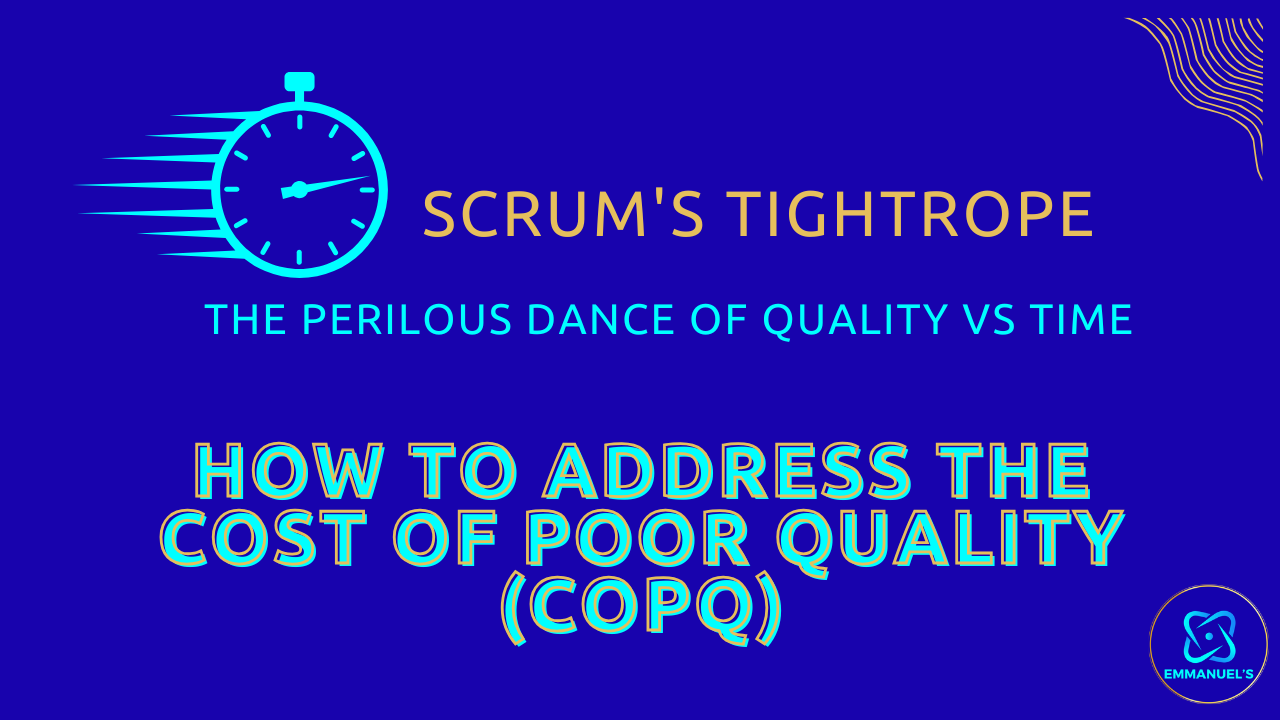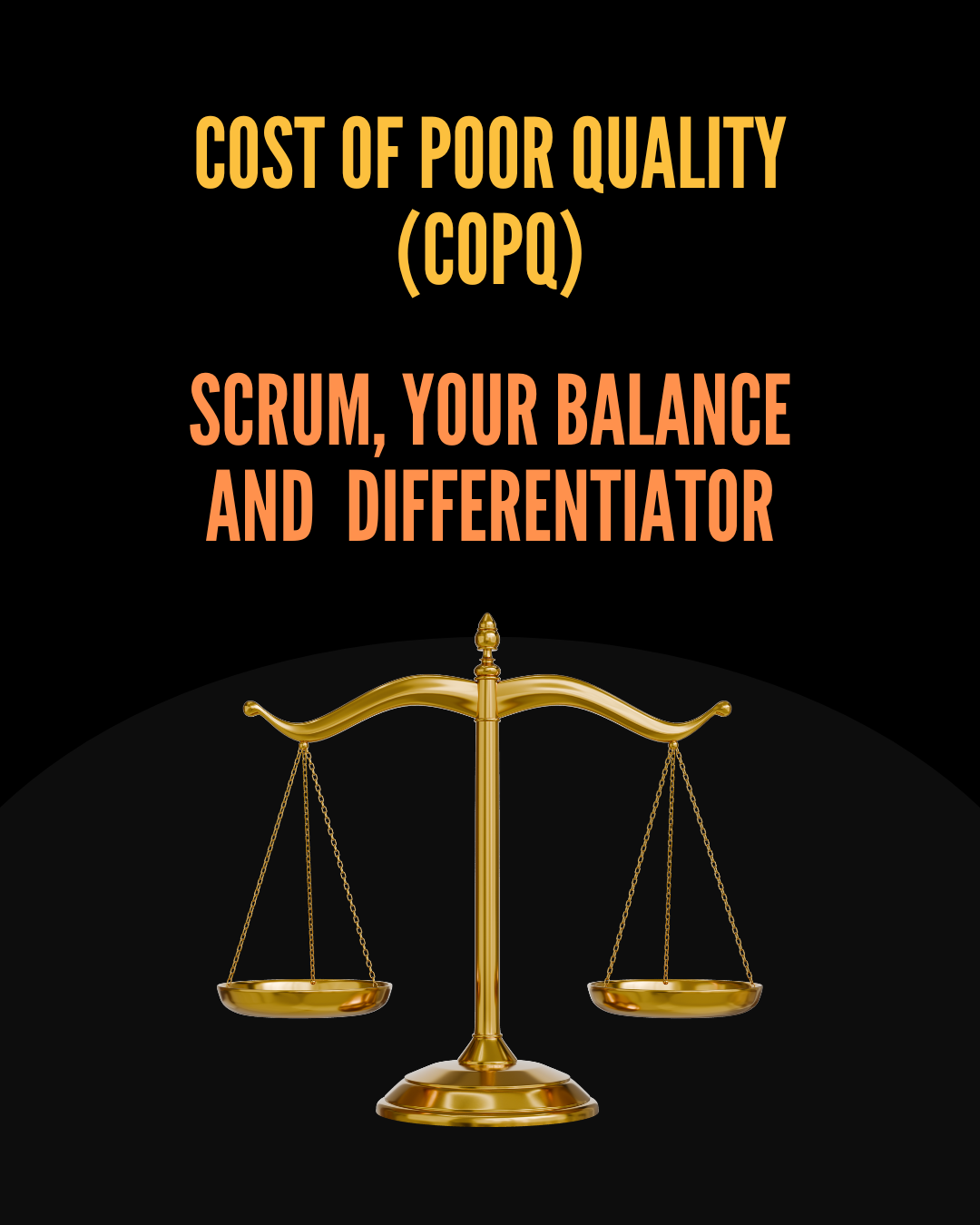Cost of Poor Quality: Reduce The Cost of Quality (COPQ)
Unlocking the potential for expansion means addressing the Cost of Poor Quality head-on. By identifying and eliminating inefficiencies, businesses increase profitability and improve customer satisfaction, transforming challenges into opportunities as your market differentiator.

Have you ever considered how much poor quality within your organization could be costing you?
The Cost of Poor Quality (COPQ) is a critical concept that reveals the hidden financial and non-financial burdens associated with inefficiencies, defects, and subpar processes. It encompasses all costs incurred when a product or service fails to meet the required quality standards.
As businesses strive for excellence, understanding and strategically reducing COPQ becomes paramount.
By addressing these costs head-on, companies enhance their operational efficiency, elevate customer satisfaction, and achieve profitability while building resilience.
This article examines innovative strategies, particularly those utilizing Scrum, to minimize COPQ, thereby paving the way for a prosperous future.
Understand and Reduce The Cost Of Poor Quality (COPQ)
COPQ represents the total sum of all expenses tied to quality issues throughout an organization. It’s often categorized into:
- Failure Costs: Occur when quality requirements are lacking.
- Internal Failure Costs: (e.g., scrap, rework, downtime) occur before the product reaches the customer.
- External Failure Costs: (e.g., warranty claims, returns, high support, lost business, damaged reputation, reduced employee morale, lost opportunities) happen after delivery.
- Appraisal Costs: (e.g., inspections, testing, quality audits) incurred to detect defects.
- Prevention Costs: (e.g., quality planning, employee training, robust quality management systems) are investments made to prevent poor quality from occurring in the first place.
While prevention costs are investments, they are ultimately more economical than addressing problems after they occur. Research indicates that these quality-related costs consume 15-40% of a business’s revenue, making COPQ reduction a considerable financial imperative.
Organizations particularly reduce COPQ by establishing robust quality metrics to track performance and implement initiatives that streamline processes while minimizing expenses associated with delivering subpar quality.
Scrum’s Tightrope: The Perilous Dance of Quality vs Time (and COPQ)
In the dynamic world of project management, there’s a constant, often perilous, dance: the tension between Quality and Time.
Stakeholders rightfully watch the Budget, creating a tightrope walk where any misstep sends your product delivery spiraling, directly escalating COPQ.
Compromising quality to hit a deadline is a costly illusion. The later an issue is discovered, the exponentially more expensive it is to fix—it directly impacts your COPQ.
A buggy or subpar product drains resources and damages your reputation, erodes customer trust (incurring external failure costs), and derails your product’s future. Yet, the initial investment in robust quality assurance often looks like an “added cost” on the books, misleading many into believing it’s a trade-off for speed.
This tension is not well understood, leading to a hidden dilemma that causes significant project slippages and inflates your Cost of Poor Quality.
The Hidden Cost of Unstable Products: When Quality Issues Propel COPQ
The peril on this tightrope often emerges when organizations fail to bake quality assurance into delivering product value from the outset.
Think about it: when the product is unstable—riddled with known (or even unknown) flaws—creating new Increments, making changes, or even just testing existing features takes longer.
Every new piece of functionality built on a shaky foundation multiplies the effort, leading to frustrating and unnecessary delays.
This dynamic is a silent strain on efficiency, directly increasing your COPQ by accumulating internal failure costs, which ultimately result in spending both time and money in the long run.
Stakeholders, witnessing their timelines slip and budgets overrun, see their trust in the Scrum Team continuously erode, leading to unproductive bickering and ultimately, project failure.
It is the definition of “firefighting” – a reactive, chaotic response that undermines predictability and calm, and fuels further COPQ.
Your Scrum Team: An Asset, Not a Commodity (For COPQ Reduction)
Preventing this perilous dilemma begins with a fundamental shift in perception: viewing your Scrum Team as a strategic asset that requires investment, rather than a mere commodity that costs money.
When the Scrum Team is viewed and treated as an asset, it entrusts them to resolve these dilemmas proactively and significantly reduce COPQ:
- Confident: Valued and supported teams are confident in their abilities and decisions, especially when navigating trade-offs between speed and quality. This confidence translates to proactive problem-solving, reducing internal failure costs.
- Self-Organizing and Self-Managing: Entrust teams to take ownership of solving the Quality vs. Time vs. Budget dilemma. They actively bake in quality, understanding its long-term benefits (reduced COPQ), and collaboratively adjust their approach.
- High-Performing: A well-balanced, cohesive, and cross-functional Scrum Team becomes a well-oiled machine. By equipping them, they proactively address quality through continuous testing and feedback, ensuring that achieving speed doesn’t compromise the product’s integrity, thus minimizing COPQ.
Baking quality assurance into delivering product value from the outset (a core Scrum practice), your Scrum Team achieves remarkable efficiency. Instead of trading quality for time, they often accomplish up to twice the amount of work in half the time.
This seemingly counterintuitive truth, which directly reduces COPQ, is available to every Scrum Team and its stakeholders who embrace this mindset.
Why Is Understanding The Cost Of Poor Quality (COPQ) Important?
Understanding the importance of quality and the impact of poor quality on businesses is paramount in our competitive market, as it directly affects your bottom line and sustainability.
Calculating COPQ (through quality cost systems) enables organizations to pinpoint precisely where improvement efforts are needed.
- Short-term vs. Long-term: While businesses might initially choose to pay for poor quality control (e.g., lower prevention/appraisal costs), this leads to significantly higher expenses in the long term (external failure costs).
- Direct Relationship: The relationship between quality and cost is direct; higher-quality products or services typically result in lower costs associated with quality problems.
- Strategic Investment: Implementing robust quality systems and conducting regular quality assessments (including prevention and appraisal costs) are essential investments that actively reduce the cost of failures, transforming quality from an expense into a competitive advantage.
By establishing strong quality metrics and streamlining quality processes, organizations reduce their Cost of Poor Quality (COPQ).
Ultimately, preventing the delivery of poor-quality products or services is always more economical than addressing problems after they occur.

How To Reduce The Cost Of Poor Quality (COPQ) with Scrum
Reducing COPQ is needed by organizations seeking to enhance their bottom line while improving customer satisfaction. Scrum provides the ideal framework and strategies to systematically decrease expenses related to defects, rework, product stability, and customer complaints:
- Integrate Quality Throughout (Definition of Done): Scrum fundamentally shifts quality from a final check to a continuous activity. The “Definition of Done” (DoD) ensures that every Increment delivered in a Sprint meets stringent quality criteria, preventing defects from accumulating.
- Iterative Development and Feedback Loops: Short Sprints and regular Sprint Reviews ensure continuous testing and frequent feedback from users and stakeholders. These enable the early identification and resolution of quality issues, thereby reducing the cost of fixing problems later (external failure costs).
- Entrusted and Engaged Teams: Scrum Teams are self-organizing and accountable for their work, including quality. Proficient staff are more likely to identify and address quality issues proactively, fostering a culture that prioritizes quality.
- Continuous Improvement (Retrospectives): Sprint Retrospectives are dedicated events for the Team to inspect their process and identify ways to improve quality and reduce waste. It embodies methodologies like Lean (eliminating waste) and Six Sigma (systematic defect reduction).
- Transparency: Scrum artifacts (Product Backlog, Sprint Backlog, Increment) and events make the state of quality visible to all, fostering trust and enabling collective problem-solving to reduce COPQ.
By systematically implementing these Scrum strategies, organizations significantly reduce COPQ, improve product quality, and simultaneously increase profitability.
Understand and Master Your Agile Journey with The Scrum Whisperer
To fully unlock Scrum and effectively implement Agile Risk Governance (which inherently reduces COPQ) within your organization, sage guidance makes all the difference.
The Scrum Whisperer offers a range of resources designed to help you, whether you’re just starting your Agile journey or aiming to elevate your existing teams.
Unlock Your Prospect with The Scrum Whisperer
- Join Our Community: Want continuous insights on mastering COPQ reduction and building high-performing Agile teams? Join The ScrumWhisperer’s Free Forever Membership! Get exclusive content, strategies, and become part of a vibrant community. Plus, bring your specific quality challenges to the Free Live Scrum-themed Q&A Events for direct assistance!
- Practical Strategies and Comprehensive Guides:
- Ready for the ultimate foundation in Scrum, including how it inherently enables quality and reduces COPQ? Download your FREE eBook Preview: Mastering Scrum: Your Compendium.
- Buy the complete. Get actionable insights you use today. Mastering Scrum: Your Compendium, Product Delivery in a Complex World eBook. This comprehensive guide covers Scrum from its roots to its most intricate details, saving you countless hours of research.
- Want proven strategies for building high-performing teams, equipped to deliver quality and minimize COPQ? Download your FREE eBook Preview: Strategies for Success.
- Buy Achieve Business Success with Efficient Project Management eBook—your essential companion to entrusting your Team today.
- Is Your Project Stuck or Needing Rescue?
- If your initiatives are struggling with persistent quality issues, high rework costs, missed deadlines, or budget overruns—all symptoms of high COPQ—I designed the specialized Scrum Master Project Rescue Service to implement Agile principles and get your projects and teams back on track for consistent and efficient product delivery.
- Turn Your Project Around with Sage Scrum Master Guidance!





